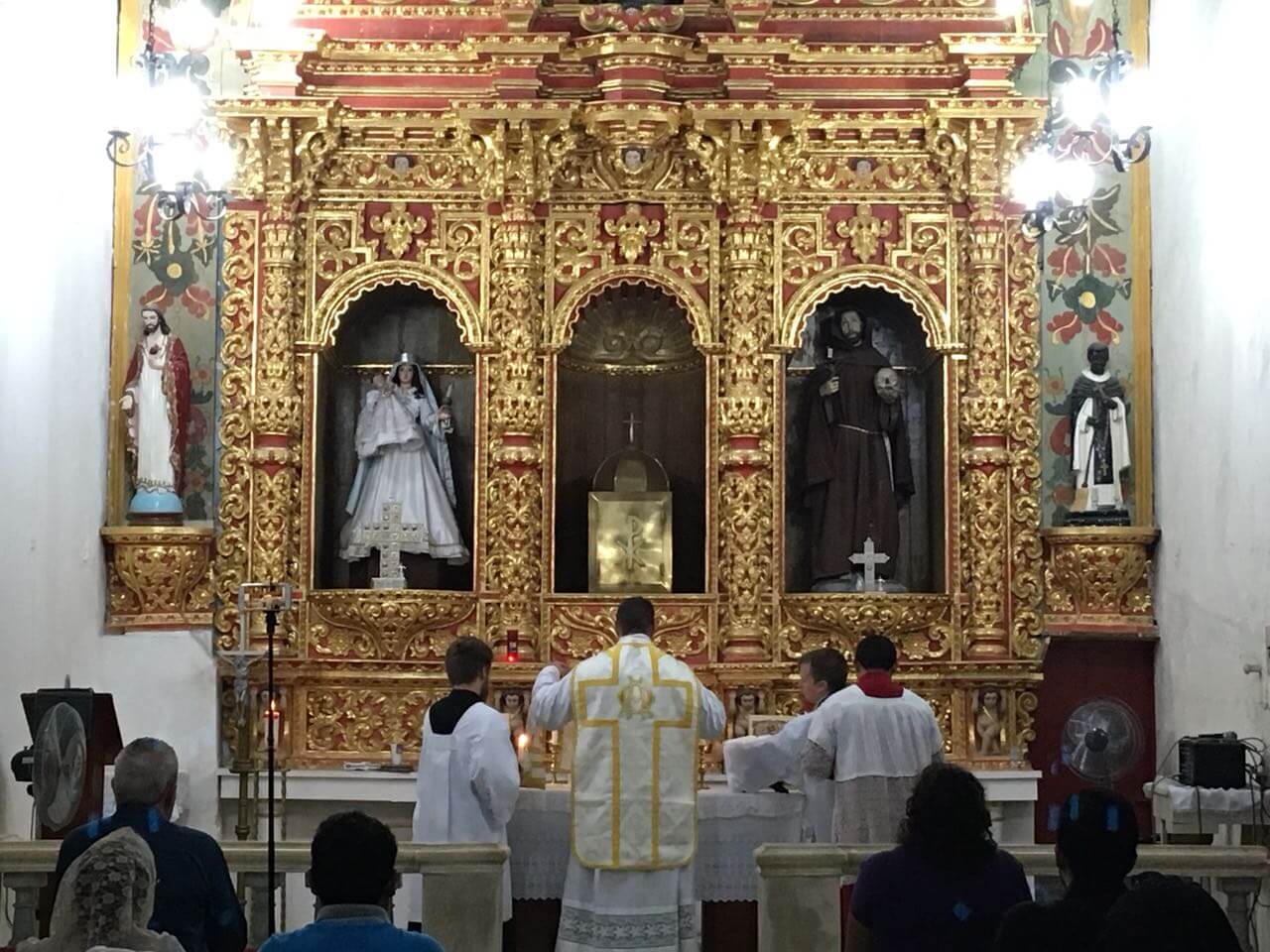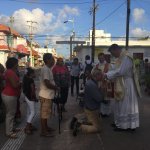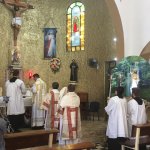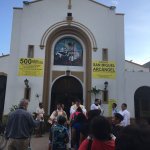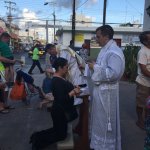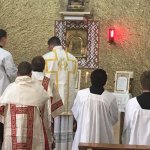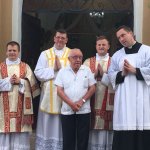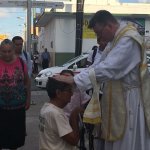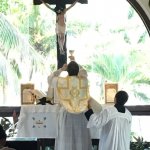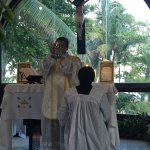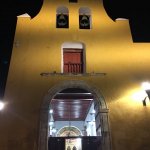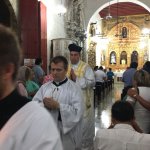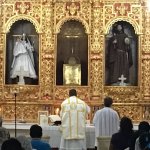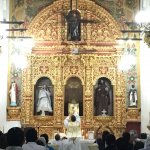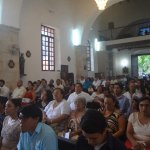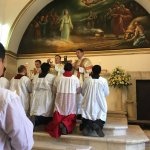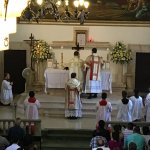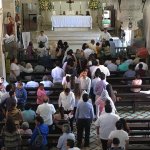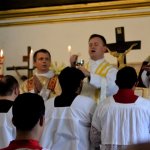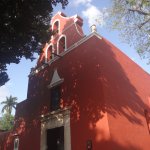The following is a guest post by Fr. Daniel Heenan, an American priest in the Priestly Fraternity of St. Peter (FSSP) currently serving the faithful in Mexico.
By Fr. Daniel Heenan, FSSP
On May 3rd, 1518, the feast of the Finding of the Holy Cross, a Spanish expedition sent from Cuba under the command of Juan de Grijalva landed on the coast of the island of Cozumel. Although they could not stay long on account of the hostility of the natives, Fr. Juan Díaz, a diocesan priest from Seville, was able to celebrate the first Mass in what is now the territory of Mexico.

Fr. Diaz later died a martyr at the hands of the cannibalistic natives, but not before he was able to baptize, with the help of several companions, 1,100,000 souls.[1] Nearly one year later, the famous expedition of Hernán Cortés, with about 600 Spaniards, landed on the mainland of Mexico at Veracruz, so named because the Spaniards landed on Good Friday, 1519. It would take them just over two years to topple the Aztec empire begin the remarkable history of Catholic Mexico.[2]  From May 4-6, 2018, the island of Cozumel was host to the festivities in honor of the 500th anniversary of that first Mass in Mexico. The Priestly Fraternity of St. Peter had the honor of celebrating a Solemn High Mass in the parish church near the site of that first Mass in Mexico according to the same rite that Fr. Juan Díaz would have used to offer Mass there 500 years earlier. These days, Cozumel is primarily a tourist destination. And the Mass, for many who passed by, was yet another curious attraction. After the Mass, the recently ordained Fr. James Smith, FSSP gave his first priestly blessing, and a blessing was imparted with the relics of the Cristero martyrs which were brought from the FSSP apostolate in Guadalajara. A priest who happened to be in attendance who had just recently completed 50 years of priestly ordination commented that the Mass and the blessings fondly reminded him of his own first Mass half a century ago.
From May 4-6, 2018, the island of Cozumel was host to the festivities in honor of the 500th anniversary of that first Mass in Mexico. The Priestly Fraternity of St. Peter had the honor of celebrating a Solemn High Mass in the parish church near the site of that first Mass in Mexico according to the same rite that Fr. Juan Díaz would have used to offer Mass there 500 years earlier. These days, Cozumel is primarily a tourist destination. And the Mass, for many who passed by, was yet another curious attraction. After the Mass, the recently ordained Fr. James Smith, FSSP gave his first priestly blessing, and a blessing was imparted with the relics of the Cristero martyrs which were brought from the FSSP apostolate in Guadalajara. A priest who happened to be in attendance who had just recently completed 50 years of priestly ordination commented that the Mass and the blessings fondly reminded him of his own first Mass half a century ago.
In places like Mexico that have such a glorious Catholic history yet at the same time, year by year, seem to be hemorrhaging members, it seems that a spark needs to be rekindled. God forbid that the heroism of men like Cortés and Fr. Juan Díaz end up being for naught. What a shame it would be if the country they helped conquer for Christ ends up becoming secularized, Protestantized, or returns to the paganism from which it was rescued.
A new evangelization is definitely needed; a new evangelization perhaps that utilizes the methods that proved so effective 500 years ago. One would be hard pressed to identify another time in Church history when there was such an impressive and complete conversion of an entire people as occurred in Mexico. And, it was less than a hundred years ago when this land was watered by blood of so many martyrs – clergy and lay people alike – who preferred to suffer the most ignominious tortures rather than have the Mass taken from them.
Today, on the other hand, various sects are growing rapidly in Mexico, ignorance of the faith prevails, and New Age practices and occultism are on the rise. On my final day in Yucatan, I celebrated Mass in a small chapel in the tourist town of Playa del Carmen. The chapel there has a clear glass window behind the altar, so as one celebrates Mass ad orientem he looks out across the ocean where the Catholic faith first arrived from the east five centuries ago. That day my recollection at Mass was disturbed by a group of people dressed as Indians putting on a performance of pagan dances for tourists. After 500 years, one can’t help but wonder if things may have come full circle. How would Cortés have responded to such a spectacle? Nevertheless, it remains evident that many Mexicans are still spiritually hungry. Catholicism laid deep roots in this culture which are difficult to extirpate completely.
After the events in Cozumel, the missionary group consisting of four priests and seven lay people made their way north and inland. With the help of Una Voce Mexico, groups of faithful in the cities of Mérida and Campeche had requested the celebration Traditional Mass, and now we had come to provide it for them. The pastor at the parish of Santa Lucia in Mérida, like so many priests in Latin America, says six or more Masses every Sunday. Hence, he was glad to have four men in cassocks arrive to help. Without hesitating he asked us if we would like to say more of the parish Masses that Sunday and help him with confessions. We gladly agreed. The small chapel was overfilled for the noon Solemn High Mass and people were standing in the doorway watching in awe.
After the Mass and the blessing with the relics of the Cristero martyrs, the faithful expressed their gratitude and begged us to return promptly to Mérida, the city that is home to the first cathedral in mainland America. That evening, part of our missionary group made its way another two hours west to the city of Campeche, where another sung Mass was offered. There, too, the people were immensely grateful and the priest who received us at his parish expressed his desire that we make regular visits.
What a blessing it was to have been able to participate in this pilgrimage for the 500th anniversary of Catholicism in Mexico! It is always striking – and it is something I have witnessed in various parts of Latin America – to see the joy of people who experience the beauty of the Church´s traditions for the first time or for the first time in a long time. It is a sign of great hope and possibility. It is evident that there is a great hunger among many people for an experience of their faith that is, at the same time more transcendent and more solid. As one man I met recently, who was born and raised in Mexico told me with tears in his eyes after a Mass I celebrated at his parish, “I always knew I was Catholic, but until I found the Traditional Mass I never realized that that my religion was beautiful, that God is beautiful and He has to be so. My country needs to know that God is so beautiful.”
In some sense, the state of spiritual hunger is very much the same now as it was 500 years ago, and it was precisely that interior yearning then, nourished by divine intervention, that allowed for such a fruitful harvest of conversion.
For those who would like to help the FSSP Missionary work in Mexico, please visit http://www.missiontradition.us/ or their Facebook page at https://www.facebook.com/FSSPMexico/.
NOTES:
[1] Plaque at the site of the first Mass celebrated in Mexico, San Miguel Cozumel.
[2] Mexico, Land of Volcanoes, Kindle 28-62.

